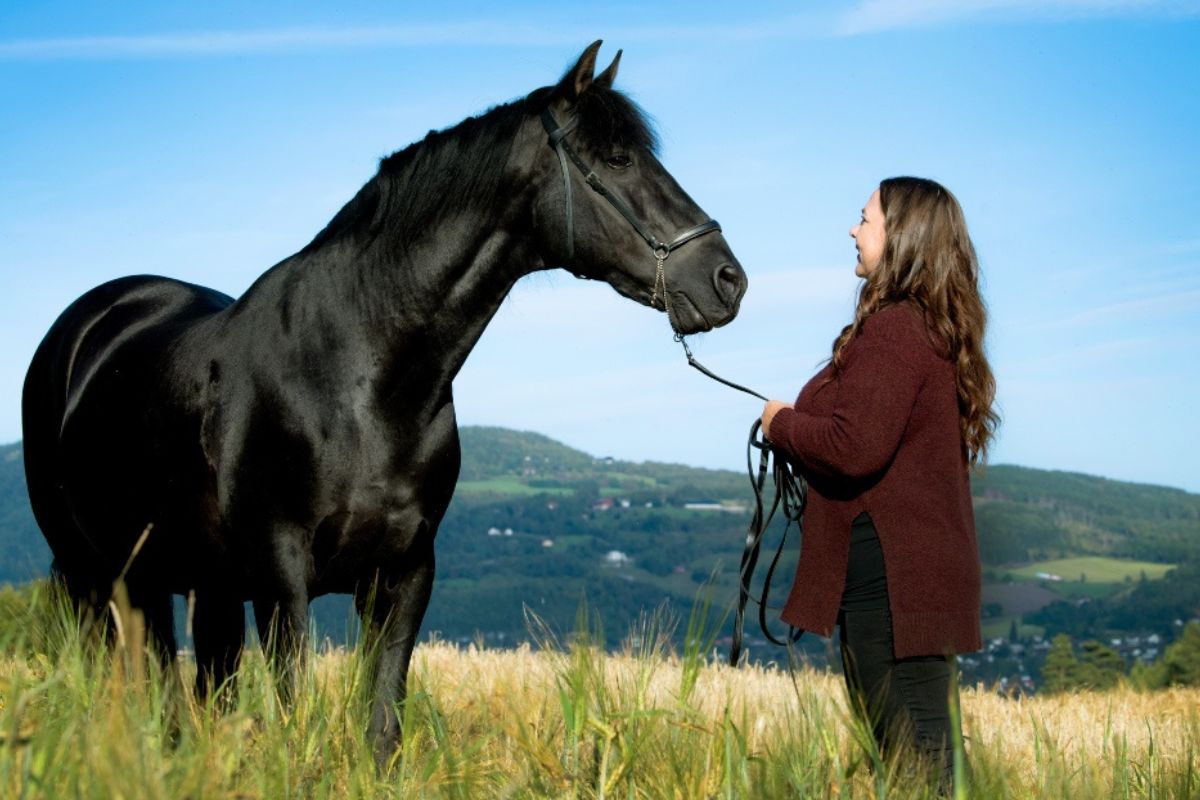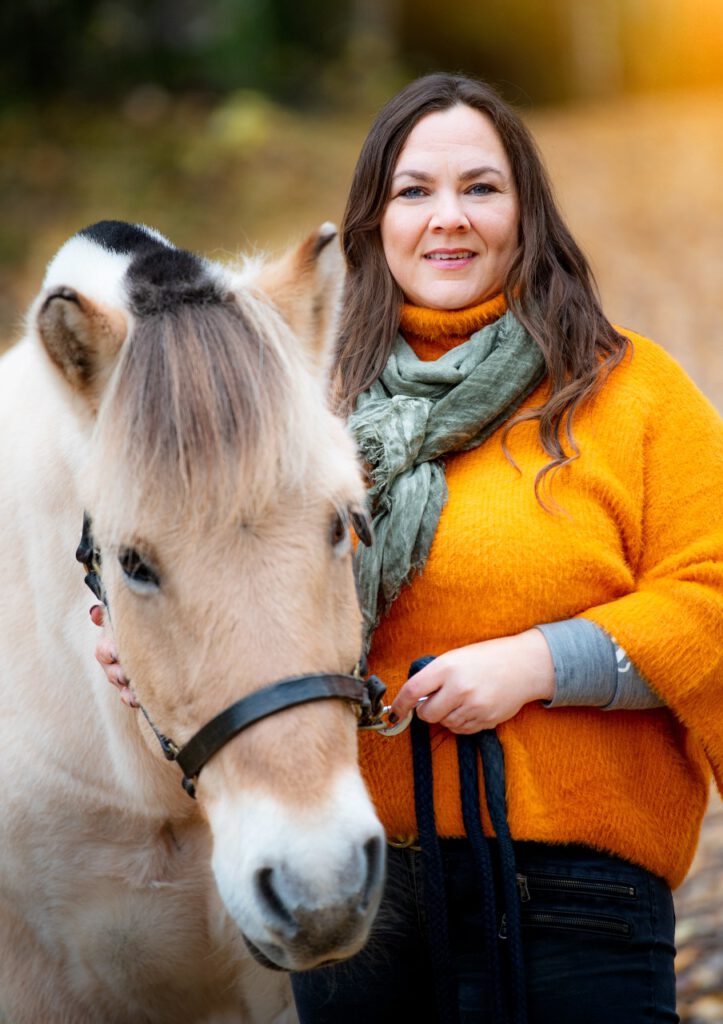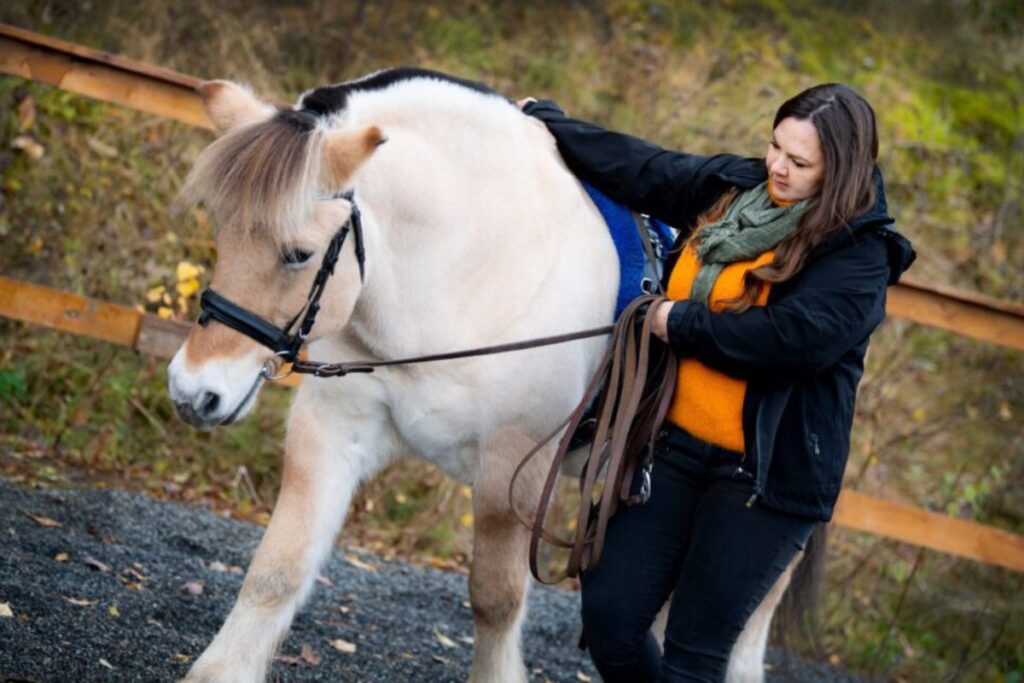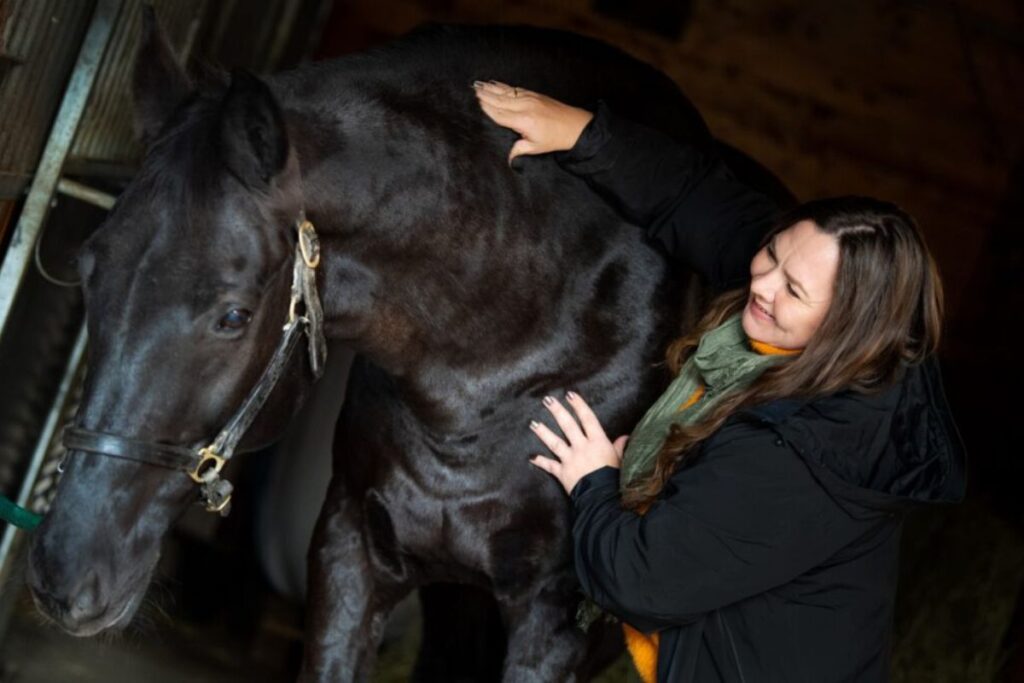Menu

As a young girl equine therapist Line Østerhagen was fascinated by horses and dreamt of becoming a veterinarian and work with animals in general. But after getting better acquainted with the profession she decided that working with very, very sick animals was not for her. Instead, she discovered other options like physical therapy and massage for animals and immersed herself in learning. To the point where she in 2005 started Nordic Horse- and Dog Therapy School (Nordisk Heste- og Hundeterapiskole), now Norway's largest educational institution for horse and dog therapy / physical treatment and training.
When Line got involved with therapist education for horses about 20 years ago, there really wasn’t much medical training incorporated as supposed to educations for therapist working with people. So, Line studied regular medicine for a year, took an education in biomechanics and the functional anatomy of the nervous system and muscle system. Practices that are all transferrable between people and horses as Line explains.
The education for “real” human therapists was deeper and more advanced and more on a medical level at the time, so it was really useful for me
Line Østerhagen
“But after a while I thought: Why should animals have therapists with less quality education than therapist working with people? The fact is that people can tell you where they hurt. Horses can’t. And I told myself: Something has to change. I have to create something. At that time, I had also educated myself as a regular teacher, so I put together everything I knew form the human side and from all the experience I had, all the extra courses and educations I had from animals, and I created an education for equine therapists.”
You may also like to read: Veterinarian: Why treating the symptoms is not enough
From a very early age equine therapist Line Østerhagen has been fascinated with horse. She had posters all over her room growing up and dreamed about horses all the time. But as a little kid her my parents could not afford to buy a horse.
“When I began in school, I started taking riding lessons at the local riding school and I really liked it,” she remembers.
Line’s interest only kept growing and never stopped. As she got older her mother did end up buying her a horse, but it came with a sacrifice.
“In Norway we have a national outfit and usually when we are 15-16 years old, we have a ceremony, a confirmation of going from being young to becoming an adult. I was told I could choose to get either the outfit or a horse. So, I still don’t have a national outfit because I chose the horse and never regretted,” Line says and laughs.
“My first horse was a national breed from Norway. A really heavy one kind of like a draft horse. But after a while I got interested in riding dressage, showjumping, and everything. That’s when I got an Arabic and I participated in different kinds of competition with this horse. From there it just developed. I got a new horse and a new horse. Sometimes I have had up to six horses at a time. I even tried having a trotter who was active in racing.”

At the age of 17 Line went on to pursue her childhood dream of becoming a veterinarian. She worked as a veterinarian assistant for a year but learned that having to put animals down and dealing with really sick animals that were hurting badly, that was not her thing. Instead, she turned her interest towards physical therapy and massage. Starting with dogs, and then moving on to horses and becoming one of the first in Scandinavia to create a school where you can train to become an equine therapist with the same level of skills as required by “human” therapists. Based on the belief that horses and human should be treated equal.
I strongly believe the therapist who treat horses should be equally well educated as the ones treating people
Line Østerhagen
“This was my goal from the beginning and one of the things I noticed was that equine therapists did not write medical journals, equine therapist Line Østerhagen explains.
"And I think it is really important for them to do so. To know exactly what they do from time to time and what improvements and changes is observed with the horse. So, I contacted a company in Norway that creates medical journals for humans and asked them if - with my help – they could create a system for animals? And they said yes, so we actually did.”
Another thing that Line realized was how difficult it was to get good insurance as a therapist in Norway. The consequence being that if a therapist did something wrong, made a mistake, there was no kind of insurance to help them get through that process.
“So, I talked to one of the biggest companies here and came to an agreement with them, where they created the first possible insurance for equine therapists, and since then other insurance companies have follow suit and now you can get this kind of insurance almost everywhere.”
You may also like to read: Asymmetry: How and why you should check if your horse is symmetrical
Another important thing that equine therapist Line Østerhagen advocates is the fact that animals do not have as many rights as patients. They cannot choose their own therapist; their owners choose for them. They cannot choose what kind of therapy they want to try. Or even tell the therapist if the treatment is comfortable or not.
“I think it is really important that the therapists are very serious about their work and well educated,” Line says.
“Not only in the therapy itself, but also that they are capable of reading the horse and then knowing their own limitations. Such as when should I ask the owner to call the veterinarian? Or when should a veterinarian look at the horse before the therapist. So, we have certain rules in my school on all of this to make sure that we really take care of the horse. That it gets the right kind of help. Because the horse cannot explain what is wrong. Sometimes the owner might even be the one who argues and doesn’t want to call the veterinarian – maybe saying things like; I don’t believe in veterinarians I want you to do it. But my job is to make sure that the horse gets the right treatment or examination, so sometimes I have to say; I don’t work for the owner I work for the horse.
That is an important part of my values. Because I don’t work for money. I don’t work for the owner. I work for the horse. And I try to influence my students to have the same values.”

At Nordic Horse-and Dog Therapy School the most comprehensive education takes three years after which you become a complete equine body therapist with experience and education in many different fields.
“In order to get there, most people start off with equine massage, because as a massage therapist you get to learn about anatomy, physiology, biomechanics and which outside sources can affect the body, “Line tells.
“You learn to complete a good examination of the horse. A massage therapist has to touch and feel the horse in all different parts and angels, and in my opinion, it is a really great start to become efficient with your hands and to be able to evaluate."
If you become good at evaluation and examination then the therapy part is not really that hard
Line Østerhagen
According to equine therapist Line Østerhagen the one thing most of her course participants have in common is that they love animals and horses in special. Some may also have worked as veterinarian assistants or in some other related occupation with horses. It also does happen that people come to her simply because they are ready to quit a boring and unfulfilling job. And instead want to work with something that gives more meaning to their lives.
“Some of our courses are a combination of online and hands on. And then we also have some that you can join solely online after you have a certain amount of knowledge regarding anatomy, physiology and injuries. One of them is our horse rehabilitation. This is meant for people who are already therapist in one way or another. “
One of Line’s key focus areas is for the therapist to be able to look and evaluate the whole horse. To work from a holistic viewpoint. If for instance a professional works only with a specific part of the body like the muscles or joints the focus will naturally turn to that particular part. Line explains it this way.
One of my goals is to have a more holistic view and a great overview of everything
Line Østerhagen
“To have a knowledge from different kinds of treatments. Because, if you know enough about both massages, stretching, tricker points, exercises for rehabilitation, joints, and acupressure, then you have a more complete system. You can choose the tools that makes most sense for the horse at any given moment. I think that is really useful for the horse when the therapist and owner for that matter do not get blinded with just using one technic.
Even for us humans, many people prefer to be able to go to just one place to get that overall holistic approach. People are tired of having the doctor looking at only the shoulder. Maybe the shoulder problem started somewhere else. It has been quite popular in Norway for a while. People are setting up clinics with different kinds of therapists under one roof. Then patients can be looked at and discussed by different professionals. Instead of having to go to one therapist after another and only get fragments from each person. They feel the need for an overview, a more holistic approach.”
According to equine therapist Line Østerhagen this does not mean that every therapist needs to be a specialist in in every single aspect. We all know it is difficult to know everything about everything. But a general knowledge of the many different areas can benefit the horse.
“I think it is good to have some kind of specializing and work together with other professionals that have other competences than yourself. It is something I have done a lot. And I work with veterinarians, equine dentist, farriers and other areas of expertise that I do not deal with myself. But it is important to have some kind of knowledge to know when to bring in help from another expert. This opens up for a cooperation.”

Over the past 20 years, where equine therapist Line Østerhagen has been working with animal therapy, she has noticed how much the approach to animal welfare has changed. From her point of view social media could have something to do with it. Because we have become able to spread information and get information in a new way. This has in many ways helped the process.
When I first started only a few people in Norway knew about equine therapy and massage. Sometimes I was even asked if I got paid for cuddling the horse
Line Østerhagen
“But over the years people have realized how important it is. What it can do to the improvement of performance and the result we can see in the horse. For example, when I started there wasn’t nearly this focus on saddle fitting. Or what kind of bit the horse had. Or the kind of focus on horseshoeing and how to do it right and the quality of the farrier. So, I do think it has become a lot better now.
Almost every horse owner knows the importance of a saddle that really fits the horse, having a great farrier, and being aware of the horse’s wellbeing in general. The focus has shifted from just training the physical aspects to also paying attention to the way the horse responds to the things you are asking it to do." Line says this and adds how the mental aspects have also moved into focus.
“Maybe as far as the mental part is concerned, we still have things to work on. If you look at dogs, we do have a better way of training them, than we do with horse. There is still a lot of punishment being used in the training of horses. And that is one of the things that I am working on now. How important it is for the physical health of the horse that it is in a good mental state. Those two really go hand in hand. And the mental part is something that we are going to have even more focus on in the future.”
Even with the vast amount of knowledge equine therapist Line Østerhagen has acquired by now, she will never stop further educating herself. At the moment she is finishing up becoming a clicker instructor. And although it is an education for working with dogs, she believes that the same principles can be applied to horses.
“It really is not that different. And I am always searching for new ways to gain knowledge on how I can motivate the horse to do all the things I want it to do. Getting it to feel that this is fun. So, I think it is an important combination of the physical and mental training. For example, I think it is really difficult to do the special exercises that we use in rehabilitation without having the knowledge on how to motivate the horse. To teach and reward. It is bad for an injured horse if you have to argue with it and it becomes a negative thing for them. They need less stress and more fun and motivation when they are injured. It has been an eyeopener for me to gain the knowledge of both aspects and to see it have such a positive effect.”